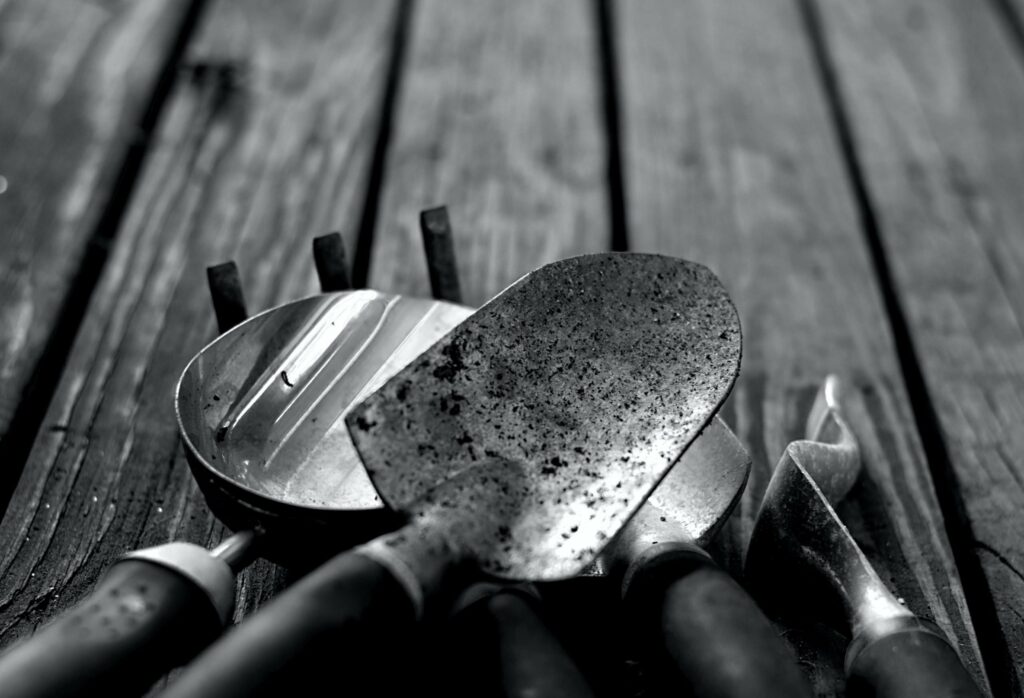Spring is coming, and so is gardening season! We’re eager to revive our gardening tools and get to work in our yards. But the truth is, our gardening and landscaping tools spend most of the year in the tool shed. Today we’re answering this question: how can we best maintain our tools to make sure they’re ready to use when we need them?
Before we dive into the details, here’s what you’ll need to get started:
- Protective Equipment. Your safety is of the utmost importance. Wear protective eyewear, a dust mask and gloves to prevent injury when cleaning and handling tools.
- Cleaning Supplies. Garden hose, old rags/towels, scrub brush, steel wool.
- Sharpening Tools. Metal file, sanding stone, specialized sharpening tools.
- Sanding Equipment. We suggest using a medium grit sandpaper.
- Oil Lubricant. Motor oil, PB Blaster, WD-40, boiled linseed oil, lamp oil, cooking oil, tung oil.
Cleaning and preventing are much better than replacing! Regularly cleaning and lubricating your tools will help them to work properly and prevent rust.
Routine Cleaning
Remove dirt and rust. Shovels, pitchforks, rakes, and similar tools typically build up a lot of dirt during use. The easiest way to clean them is to hose them off and dry them immediately. However, you may need to scrub off dirt that has been dried on. Steel wool works great to remove rust, polish the metal surfaces, and remove excess dirt. Dry your tools off with an old towel when finished.
Clean with oil/steel wool. For pruners, shears, and similar tools, clean with an oily rag or WD-40. Scrub with steel wool as needed.
Sanding. Use sandpaper to smooth worn wooden handles. This is especially helpful for preventing splinters. Sandpaper can also be used to remove rust. Wipe down the tools when you’re finished to remove any sanding dust from the wood or metal.
Wash Away Harmful Chemicals. If you use tools to apply a chemical substance like fertilizers, thoroughly clean the tools immediately after use. These chemicals will quickly corrode metal surfaces.
Preventative Maintenance
First, never leave your tools outside. Harsh weather will deteriorate them faster than just about anything. Make a habit of putting them away in a shed or garage.
Sharpening. Sharpen pruners and similar tools with a specialized sharpening tool designed for the shape of it’s cutting blade. Sharpen shovels and other tools with a metal file. Use enough pressure to smooth away nicks and scratches and give your tools a sharp edge, but not too much that you grind away and thin the metal. Most saws, with the exception of chain saws, typically aren’t sharpened because it’s relatively inexpensive to replace the blade.If you do need to sharpen your saw blade, use a cross cut file and a triangular file that match the teeth of the blade being sharpened. For axes, use a metal file then finish by rubbing a sharpening stone in a circular motion along the blade on each side. Use a grinder for more extensive damage, dipping the head of the ax in a bucket of water after each pass.
Lubricate with Oil. After cleaning and sharpening, metal tools should be lubricated to prevent rust formation. Apply the lubricant to both the metal blade and wooden handle of the tool. WD-40, motor oil, and PB Blaster are a few lubricants we recommend. When you’re done, use a rag to wipe away any excess oil.
- Here’s a quick tip: fill a 5 gallon bucket about halfway with sand, then pour in enough new or used motor oil to coat the metal surface. Stick the tools in the bucket using an up and down motion to clean the metal surface. The oil in the mixture will coat the metal to protect it from rust and moisture. You can even use the bucket as a stand by storing your tools in it if you’d like.
Tighten Bolts. For scissors and shears, occasionally tighten the bolt that holds the two halves together with an adjustable wrench. Over tightening will bind the blade, so watch for this and loosen the bolt if necessary.
At TrueDecks, having tools that work properly is vital for the work we do on your deck. We’ve just scratched the surface on how to properly care for all of your tools, but hopefully we’ve helped you develop a better understanding of the basics. Keeping your garden and landscaping tools clean, dry, and lubricated is well worth the effort!
What other maintenance tips have you found useful for your tools?




